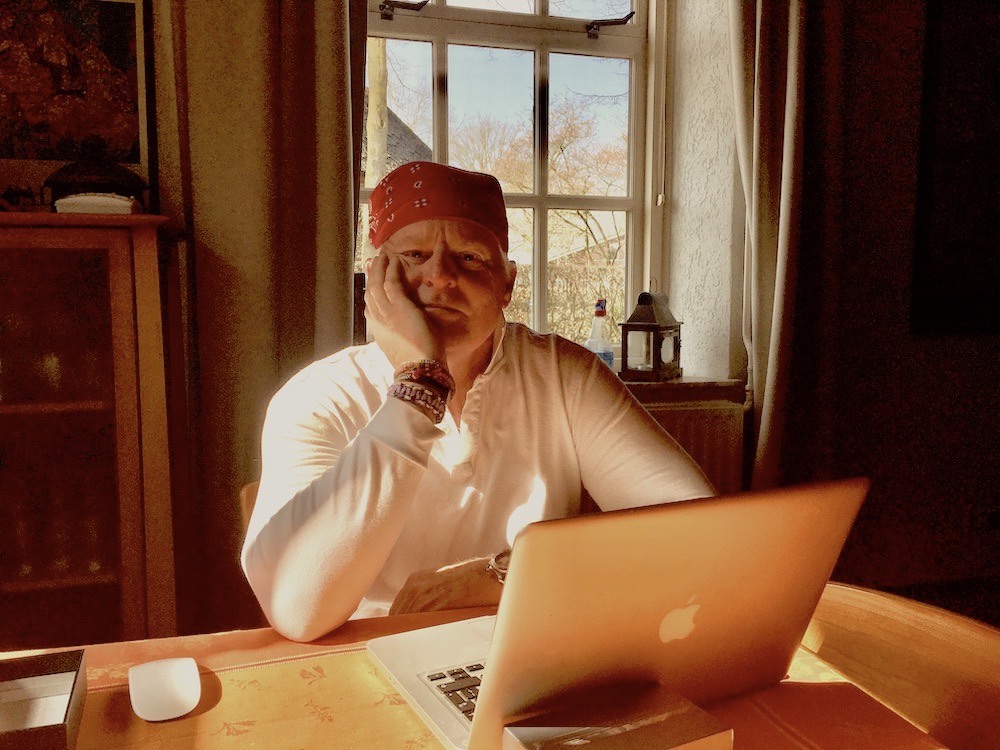This is the silver lining of COVID-19 … I promise you, working remotely is going to make your life better.
Two weeks into the coronavirus pandemic, I had an epiphany: I’m probably never going to work in an office again, and neither are you, at least anytime soon. I had that realization during HighTechXL’s Fastrackathon on Wednesday, 25 March, which brought together about 80 people around six technologies in a virtual deep-tech hackathon. (More about that in a later post.)

It was the third such reverse-hackathon, but the first that was totally virtual using Microsoft Teams, Slack and Google Drive. It was a huge success, with participants praising how focused it was. And I started thinking, why couldn’t a lot of companies use the latest wave of collaboration platforms to expand their reach globally?
Probably because it feels weird.
“It feels totally foreign because we’re used to interacting in person,” said Cheryl Boyd, who is one of the FasTrackathon organizers. But you get used to it … and better at it, she said. Married since 1991, Cheryl and I have worked remotely for decades for just about every job and business we’ve had including Dispatches, where we work a lot from home as co-CEOs.
As we enter a critical phase of the coronavirus lockdown, I wonder how much productivity will get washed out of every advanced economy as people try to adjust to life without offices, personal assistants, staff meetings and routines? Likely, more than we’ll ever know.
Here’s what I do know: There are two kinds of people … people who love going to the office and all the interpersonal drama that spawns, and guys like me who do just fine working in splendid isolation. I’m an extrovert who lives to socialize, but I get soooo much more done working remotely.
Cheryl notes that suddenly with the pandemic, work is more intense. It feels like we have to be focused all the time. Suddenly working from home means an even more packed schedule for us.

HOW IT ALL BEGAN
Somewhere along the line on some remote fire base in Kosovo, Afghanistan or Iraq, connected to the Internet via an $11 per minute Iridium sat phone, I realized that wherever I am is my office. I can’t tell you how well this has served in the digital age.
In 2010 when we started our first pure-play digital media company, everyone was working out of the neighborhood Starbucks, not that there’s anything wrong with that. Just give me a home office any time.
BUT, you have to completely change your work habits, starting with familiarizing yourself with chat and video conferencing apps. Let’s start with the tech. And by the way, when is someone going to create tools to make us all Instagram beautiful on webcam?

WAIT … OKAY … NO WAIT. OKAY, NOW I CAN SEE YOU
Hate Skype? So do I. But there are a million options for real-time streaming video, which is something that used to be a not-great experience for most of us from the Skype Generation.
None of these video-conferencing platforms is new, but everyone is getting more acquainted with their features because we can’t go to the office and we still have to stay productive. Also, some of these subscriptions can get pricy. Slack is €6.50 per month per user, for example.
What’s so great about it? “It works,” says Daniel Hatton-Johnson, a British expat in Eindhoven’s startup scene. No one has to sign up. You just share a link and get people on the call. And you can message up to 150 people in your group, sharing files and whatever.
G-Suite subscribers can use advanced features including having up to 250 participants.
The first online telecom app that started the revolution. Still what most people use and perfectly fine as long as you have the bandwidth to support it. A Microsoft product these days, so don’t expect warm and fuzzy UX. But 171 million registered users can’t all be wrong.
Slack is a multi-channel group work platform. You can chat, upload files, share files and a million other things. Which is why the Internet broke it this week, with 12.5 million concurrent users, according to The Verge.
There’s a free version and paid version, and Slack is overhauling its design.
Another group work platform using Microsoft products and integration. All the Microsoft suite. Cheryl just used it for group meetings, which can be video or audio. “We used Microsoft Teams, and the presenter shared his or her screen to show the PowerPoint presentation for the FasTrackathon introduction and kickoff, for technology presentations and for final pitches at the end of the event,” she said.
Crazy popular during the pandemic, with 44 million daily users. But it’s still a Microsoft product and all that implies, with less friendly UX.
Three words: Two. billion. users. A basic texting app with calling function such as group chats and other stuff, and everyone seems to love it. It’s okay … but people, quit sending me stuff like full-length stories and pictures on this.
The good part about this latest wave technology is it’s easy to learn and always getting better.

THE HUMAN TOUCH
Here are my tips from 20-plus years of working remotely.
• Start early (but don’t go crazy)
I wake up about 6 a.m. or 6:10 a.m., fix some coffee and go straight to work. I started doing this as a military reporter in Iraq and Afghanistan, because if you’re not at the base dining facility by 0600, you miss breakfast, then the squad mission briefings.
Of all my habits, this has served me the best as an entrepreneur. Why? Because from 6-ish to, say, 9 a.m., you work uninterrupted and get an amazing amount done. Mornings are too good to waste. Save emails for the evening as you wind down. In the a.m., cross off the most mission-critical tasks from your to-do list.
What I learned: Don’t do what I did and give in to the temptation to get up in the middle of the night and answer emails. That scares people when they see the time stamps.
• Set a time limit
It’s temping to do what I’m doing now … working late. I set a final time of 8 p.m. to stop. Otherwise, I could work until I fall into bed, which I did for three years with our first media company. I paid a high price … I lost most of my friends. My mental health wasn’t great (read, “total burnout”) and I gained a lot of weight. But to be clear, this was a digital media startup. That’s just what you do.
What I learned: Just turn off your phone at 8 p.m. and read or look in on the Queen or Tommy Shelby.
• Leave behind the American work culture
One of the most difficult adjustments for Americans in the Netherlands is the way the Dutch like to work and meet. Always during the work day, and they like to meet about everything, because this is a collaborative society. They also tend to leave work at 5.
This is all good.
Working from home in the U.S. without the discipline of an office, there was none of that. I had countless 7 a.m. (and earlier) breakfast meetings (including weekends) with investors and sources. Then we had drinks after 6. You get a lot done and you build relationships. But you also run the risk of getting fat gorging on latkes, not to mention the whole alcohol-dependency thing.
What I learned: Americans will work themselves to death if you let them.

• Carve out dedicated space for a home office, even on vacation
Don’t fall victim to working in your bedroom, living room or kitchen. It’s like working crammed into a hotel room, and I hate working in my hotel room on trips. It feels unnatural and random.
I always borrow someone’s office on vacation, like the time we were in St. Martin in the Caribbean and I needed to finish a project. So the people who owned the beach complex where we were staying let me work from their offices. And yes, a couple of times I had to grab their calls when they were at lunch. “Oui, bonjour … ne quitte pas!”
Creating a work space in our house reenforces the notion that I’m actually at work. In my home office, I have a decent desk and chair, some cabinets and a second table for a laptop. I also have these huge hand-written white board pages with notes and a portrait of my Great Uncle Thomas Norris, who made a fortune back in the railroad days. He reminds me what I’m supposed to be doing … building an empire.
What I learned: If you work on the road, don’t stay stuck in your room because you’ll get cabin fever. Go down to the lobby working areas and fool yourself into thinking you’re on vacation. Or barge into someone else’s office.
• Don’t cheap out: Don’t try to get by with obsolete laptops, printers and phones. Get the best – the fastest and with the most RAM – you can afford. You’ll be glad you did. That goes for SaaS platforms and even stuff like LinkedIn Prime and wifi service.
If you’re a Do-It–Yourself Expat like us, try to buy/lease the largest home you can because it gets claustrophobic if you’re trying to live and work in 65 meters2.
What I learned: Nothing frustrates me more than having to stop in the middle of doing something important to figure out why a laptop has died, or the wifi quit.
• Do the stuff in your home office you can’t do at work
By this, I don’t mean spend all day in your PJs. I mean, do what I do … line the walls with lists, notes and plans so you can visually track where you are without having do dig into some over-hyped software like Monday.com.
What I learned: This is your home, so you’re the boss even if you’re not really the boss. You can do anything you want to do. Make your space your own.
On the other hand, I have a tendency to just let stuff go and I have giant planning pages folded up in plastic boxes. My office is starting to get a little crappy. Don’t forget to straighten up every few days.
• Break up the day.
You have a lot more freedom working at home … use it wisely. If you sit in your office 12 straight hours, you’ll go crazy. I slip in a workout about noon. Cheryl takes short walks all through the day, her schedule permitting. I do weights, jump rope, sit-ups and sprints.
What I learned: Breaking up the day should include talking with someone. Don’t get isolated and weird.
• About that snacking:
The biggest hazard working at home is food. As our colleague Nancy Wellendorff Church noted one day, I’m a sneaky snacker, munching on something all day long. Lately I’ve shifted toward fruit and whatever, but the most dangerous thing about food is you use it as a reward. “Oh, look at all the work I did. I’m celebrating with ice cream and beer!”
What I learned: The good thing about not going to the office is not doing lunch. I’ve lost three pounds since mid-March because I’m not indulging in Subway sandwiches followed by snacks at the Starbucks and Tony Chocolonely at the Albert Heijn on High Tech Campus Eindhoven.
I’ve saved the best for last … working remotely, you don’t have to share the bathroom with colleagues.
Co-CEO of Dispatches Europe. A former military reporter, I'm a serial expat who has lived in France, Turkey, Germany and the Netherlands.















